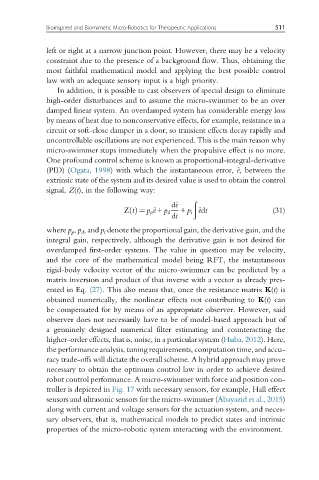Page 517 - Handbook of Biomechatronics
P. 517
Bioinspired and Biomimetic Micro-Robotics for Therapeutic Applications 511
left or right at a narrow junction point. However, there may be a velocity
constraint due to the presence of a background flow. Thus, obtaining the
most faithful mathematical model and applying the best possible control
law with an adequate sensory input is a high priority.
In addition, it is possible to cast observers of special design to eliminate
high-order disturbances and to assume the micro-swimmer to be an over
damped linear system. An overdamped system has considerable energy loss
by means of heat due to nonconservative effects, for example, resistance in a
circuit or soft-close damper in a door, so transient effects decay rapidly and
uncontrollable oscillations are not experienced. This is the main reason why
micro-swimmer stops immediately when the propulsive effect is no more.
One profound control scheme is known as proportional-integral-derivative
e
(PID) (Ogata, 1998) with which the instantaneous error, ^, between the
extrinsic state of the system and its desired value is used to obtain the control
signal, Z(t), in the following way:
e
d^ ð
Ζ t ðÞ ¼ p p ^e + p d + p i ^edt (31)
dt
where p p , p d , and p i denote the proportional gain, the derivative gain, and the
integral gain, respectively, although the derivative gain is not desired for
overdamped first-order systems. The value in question may be velocity,
and the core of the mathematical model being RFT, the instantaneous
rigid-body velocity vector of the micro-swimmer can be predicted by a
matrix inversion and product of that inverse with a vector as already pres-
ented in Eq. (27). This also means that, once the resistance matrix K(t)is
obtained numerically, the nonlinear effects not contributing to K(t) can
be compensated for by means of an appropriate observer. However, said
observer does not necessarily have to be of model-based approach but of
a genuinely designed numerical filter estimating and counteracting the
higher-order effects, that is, noise, in a particular system (Huba, 2012). Here,
the performance analysis, tuning requirements, computation time, and accu-
racy trade-offs will dictate the overall scheme. A hybrid approach may prove
necessary to obtain the optimum control law in order to achieve desired
robot control performance. A micro-swimmer with force and position con-
troller is depicted in Fig. 17 with necessary sensors, for example, Hall effect
sensors and ultrasonic sensors for the micro-swimmer (Abayazid et al., 2015)
along with current and voltage sensors for the actuation system, and neces-
sary observers, that is, mathematical models to predict states and intrinsic
properties of the micro-robotic system interacting with the environment.

